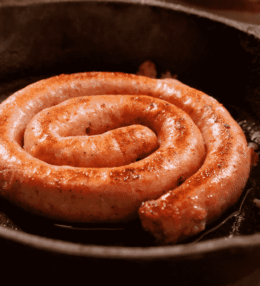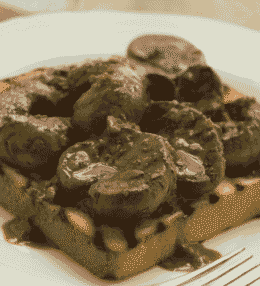
- View
Table of Contents
ToggleLaal Maas is a fiery and flavourful mutton curry from Rajasthan, a region known for its bold and hearty cuisine. This dish, with its vibrant red colour and rich, spicy gravy, is not for the faint hearted.
Traditionally prepared using a unique combination of red chilies and tender mutton, Laal Maas showcases the intensity of Rajasthani flavours. It’s a dish that warms you from the inside out, making it a staple during special occasions and winter feasts.
Want to dive deeper into Indian Cuisine? Don’t miss our post on 34 Traditional Indian Foods to Try
What Is Laal Maas?
Laal Maas, which translates to “Red Meat,” is a classic Rajasthani mutton curry that gets its name from the striking red hue of its sauce. The dish is famous for its use of fiery Mathania red chilies, which give it a deep, smoky flavour without overwhelming the palate with heat.
While it’s definitely a spicy dish, the heat is balanced by the tender, slow cooked mutton and a blend of aromatic spices. This combination results in a curry that is rich, hearty, and packed with layers of flavour.
Often served with traditional Indian flatbreads like bajra roti or steamed rice, Laal Maas is a dish that demands attention, both for its bold flavours and its cultural significance. Each spoonful is a burst of spice, warmth, and depth, making it one of the most revered dishes in Indian cuisine.
Ingredients and Taste
The key ingredients of Laal Maas are simple yet carefully selected to achieve its distinct taste. Mutton, usually bone in for added flavour, is the heart of the dish. The real star, however, is the Mathania chili, a local variety from Rajasthan that gives the dish its iconic red colour.
These chilies provide a smoky heat that lingers on the tongue without overpowering the other spices. The curry is built with onions, garlic, ginger, and a blend of whole spices like cumin, coriander, and cloves, which create a robust base for the mutton.
Yogurt is often added to balance the heat and add a slight tanginess, while mustard oil is used for cooking, enhancing the earthy richness of the dish. The result is a curry with a complex interplay of flavours; smoky, spicy, tangy, and deeply savoury.
When you take a bite, the first thing that hits you is the bold spice, followed by the tender, juicy mutton that has absorbed all the flavours of the slow cooked sauce. The dish’s heat is intense but balanced, leaving a warmth that lingers long after the meal is over.
A Taste of History
Laal Maas has a long and storied history in Rajasthan, dating back to the time of the Rajput warriors. Known for their hunting prowess, the Rajputs would often prepare this dish with game meat like deer or wild boar.
The intense heat of the chilies was originally used to mask the strong flavours of wild meat. Over time, as the dish evolved, it became a favourite with mutton, and the focus shifted to achieving a balance between the heat and the other flavours.
The dish was particularly popular in the royal kitchens of Rajasthan, where chefs mastered the art of slow cooking the meat to tender perfection while infusing the curry with the deep, smoky heat of the chilies.
Today, Laal Maas remains a symbol of Rajasthani culinary heritage, celebrated for its bold use of spices and its rustic, robust nature.

Rajasthani Laal Maas (Spicy Red Mutton Curry)
Ingredients
- 1 kg mutton bone-in pieces
- 4 tbsp mustard oil or ghee
- 4-5 dried red chilies soaked in water for 30 minutes
- 2 medium onions finely sliced
- 1 tbsp garlic paste
- 1 tbsp ginger paste
- 1 cup plain yogurt whisked
- 1 tbsp red chili powder Rajasthani Mathania chili preferred
- 1 tsp turmeric powder
- 1 tsp cumin seeds
- 4-5 cloves
- 2-3 green cardamom pods
- 1 bay leaf
- 1- inch cinnamon stick
- 2 tsp coriander powder
- Salt to taste
- Fresh coriander leaves for garnish
Instructions
- To begin, soak the dried red chilies in warm water for 30 minutes. Drain and grind them into a smooth paste. Set aside. In a large bowl, combine the mutton pieces with the whisked yogurt, turmeric powder, and salt. Mix well and marinate the mutton for at least 1 hour (preferably overnight) to allow the flavors to deeply infuse the meat.
- Heat 4 tablespoons of mustard oil or ghee in a large heavy-bottomed pan or pressure cooker over medium heat. Once the oil is hot and begins to smoke slightly, lower the heat and add cumin seeds, bay leaf, cardamom pods, cloves, and cinnamon stick. Sauté for about 1-2 minutes until fragrant.
- Add the sliced onions to the pan and cook until they turn golden brown, stirring occasionally to prevent burning. This step is crucial for developing the deep, rich flavour base of the curry.
- Next, add the ginger and garlic paste to the browned onions. Sauté for another 2-3 minutes until the raw aroma of the garlic and ginger disappears, ensuring the paste is well incorporated with the onions.
- Now, add the red chili paste and red chili powder to the pan. Stir thoroughly and cook for 4-5 minutes on low heat, allowing the chilies to release their vibrant colour and intense heat. Adjust the amount of chili paste according to your spice tolerance.
- Add the marinated mutton to the pan, mixing it well with the chili-onion mixture. Sear the meat for about 10 minutes, turning occasionally to ensure each piece is browned and well coated with the spices. This step locks in the flavors and enhances the meat's richness.
- Sprinkle the coriander powder over the mutton and pour in 1-1.5 cups of water. Stir well, cover the pan, and let it simmer on low heat for about 1.5 to 2 hours, or until the mutton becomes tender. If using a pressure cooker, cook for 4-5 whistles. Stir occasionally and check the liquid level, adding more water if necessary to prevent the curry from drying out.
- Once the mutton is cooked through and the gravy has thickened, check for seasoning and adjust salt if needed. Garnish the Laal Maas with freshly chopped coriander leaves. Serve hot with steamed basmati rice or traditional Indian bread like roti or naan.






